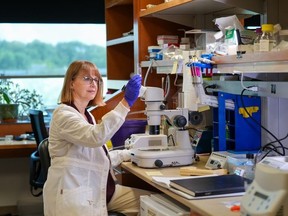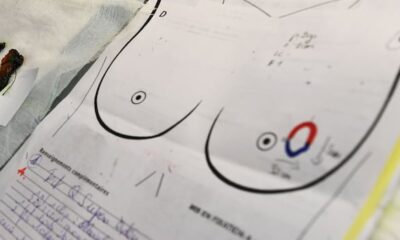Health
Scientists Unlock Genetic Key to Common Infertility Issue

Researchers have made significant strides in understanding a genetic anomaly linked to infertility, revealing the mechanics behind a common chromosomal abnormality known as *Robertsonian translocation*. This condition affects approximately 1 in 800 individuals, often going undetected until couples face difficulties conceiving or experience pregnancy loss.
A team from the Stowers Institute for Medical Research in Missouri published its findings in the journal Nature on March 15, 2023. By employing advanced genome sequencing technologies, the scientists examined the genetic makeup of three individuals with fused chromosomes, uncovering how these rearrangements occur in humans.
Historically, *Robertsonian translocations*, abbreviated as ROBs, were identified in various species, including grasshoppers as early as 1916 by zoologist W.R.B. Robertson. While many individuals carrying ROBs remain healthy, they typically possess fewer than the standard 46 chromosomes found in humans. Often, these genetic anomalies are only discovered during reproductive assessments, when carriers face a heightened risk of miscarriages or having children with chromosomal irregularities.
Glennis Logsdon, a genome scientist at the University of Pennsylvania Perelman School of Medicine, noted the importance of this research: “In my genetics classes, it was taught. People talked about how this could lead to … functional consequences – infertility and perhaps cancer. The conversation always stopped there: We don’t know how it happens.” This study addresses that gap, shedding light on the processes involved in ROB formation.
The initial draft of the human genome was unveiled in 2001, but approximately 8 percent of it remained unexplored until advancements in genomic technologies allowed for a more comprehensive understanding. By focusing on areas previously dismissed as “junk DNA,” scientists have begun to piece together the missing fragments of human genetic information.
Jennifer Gerton, a chromosome biologist at Stowers, highlighted the revelation that many researchers were unaware of the gaps in foundational genetic knowledge. Together with collaborators from the University of Tennessee Health Science Center and the National Institutes of Health, Gerton and her team have made progress in deciphering the underlying mechanisms that lead to these chromosomal rearrangements.
Human chromosomes are threadlike structures composed of DNA and proteins, condensing into an X-shape during cell division. In some cases, certain chromosomes, referred to as *acrocentric* chromosomes, undergo fragmentation and rearrangement, leading to the formation of ROBs. Unlike other chromosomal abnormalities that can result in severe health issues from birth, many individuals with ROBs lead normal lives without realizing they carry the genetic anomaly.
The new study utilized advanced sequencing techniques to investigate repetitive DNA segments on the short arms of acrocentric chromosomes, which had previously eluded researchers. David Ledbetter, a human geneticist at Florida State University College of Medicine, emphasized that without recent advancements, this research would not have been possible.
These repetitive sequences, identified as *recombination hotspots*, were found to be crucial in the formation of ROBs. The research team discovered that chromosome number 14 possesses these segments in a reverse order, making it prone to translocations when paired with other chromosomes.
As a result of these findings, Adam Phillippy, director at the Center for Genomics and Data Science at the National Human Genome Research Institute, is now exploring existing genetic databases to identify individuals who may unknowingly carry ROB chromosomes. The aim is to assess their risk for specific health issues, including cancers, infertility, and rare diseases.
André Marques, a group leader at the Max Planck Institute for Plant Breeding Research, praised the study, stating, “The study really shows how a human chromosome can fuse together, a long-standing mystery that helps a lot to explain both genetic disease and also the engine of chromosomal evolution.”
The implications of this research could extend beyond understanding infertility, potentially leading to enhanced tools for individuals to assess their reproductive risks and better comprehend genetic diseases. As scientists continue to unravel the complexities of human genetics, this investigation into ROBs marks a significant step toward solving long-standing mysteries in reproductive health.
-

 Politics4 weeks ago
Politics4 weeks agoSecwepemc First Nation Seeks Aboriginal Title Over Kamloops Area
-

 World5 months ago
World5 months agoScientists Unearth Ancient Antarctic Ice to Unlock Climate Secrets
-

 Entertainment5 months ago
Entertainment5 months agoTrump and McCormick to Announce $70 Billion Energy Investments
-

 Science5 months ago
Science5 months agoFour Astronauts Return to Earth After International Space Station Mission
-

 Lifestyle5 months ago
Lifestyle5 months agoTransLink Launches Food Truck Program to Boost Revenue in Vancouver
-

 Technology3 months ago
Technology3 months agoApple Notes Enhances Functionality with Markdown Support in macOS 26
-

 Lifestyle3 months ago
Lifestyle3 months agoManitoba’s Burger Champion Shines Again Amid Dining Innovations
-

 Top Stories2 months ago
Top Stories2 months agoUrgent Update: Fatal Crash on Highway 99 Claims Life of Pitt Meadows Man
-

 Politics4 months ago
Politics4 months agoUkrainian Tennis Star Elina Svitolina Faces Death Threats Online
-

 Sports5 months ago
Sports5 months agoSearch Underway for Missing Hunter Amid Hokkaido Bear Emergency
-

 Politics5 months ago
Politics5 months agoCarney Engages First Nations Leaders at Development Law Summit
-

 Technology5 months ago
Technology5 months agoFrosthaven Launches Early Access on July 31, 2025





















